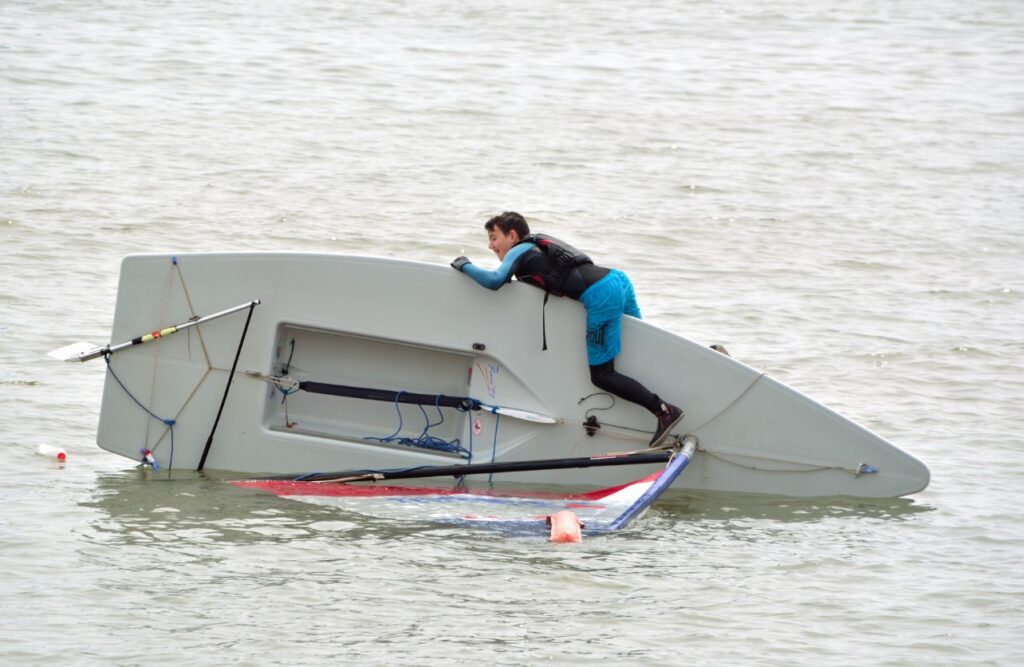When first learning to sail, keeping a few key things in mind is essential. Let’s take a look at each one below. You can also check out Takacat Americas for more fun facts and sailing tips.
Know The Wind Direction
Knowing the wind direction before you sail is crucial because it affects your sails in two ways. First, it determines which side of the boat the wind will be blowing from. Second, it determines how hard the wind will be blowing.
If the wind is blowing from the front of the boat, this is called a headwind. Headwinds are more brutal to sail in because they push against the front of the sails and slow down the ship.
If the wind comes from the back of the boat, this is called a tailwind. Tailwinds make sailing easier because they help push the boat along.
The strength of the wind also affects your sails. If the wind blows very hard, it can push your sails backward and make it difficult to control the boat.
In extreme winds, it’s often necessary to reef (reduce the size of) your sails to make them more manageable.
Practice Smooth Turns

Source: ussailing.org
Second, practice turning smoothly and gently to avoid capsizing.
Capsizing happens when your boat overturns and fills with water. It can happen very suddenly, especially in high winds or if you make a sudden movement onboard.
Most sails capsize when the wind blows onto the side of the boat, called “windward .” The wind pushes against the sails and forces the ship to heel (tilt) over until it eventually tips over.
How To Prevent Capsizing
There are several things you can do to prevent capsizing or at least reduce the risk:
1) Always wear a life jacket on board. A life jacket will keep you afloat if you end up in the water and help prevent hypothermia.
2) Check the weather forecast before heading out. For example, if the forecast calls for high winds, staying ashore is best.
3) Be aware of your surroundings when sailing. Always look for other boats or objects that could pose a collision risk.
4) Avoid sudden movements onboard. Sudden jerks can cause the boat to heel over and capsize.
5) Make sure the sails are trimmed properly. The wind can catch them and push the boat over if they are not.
6) Heaving-to is an excellent way to take a break or rest while sailing. This involves balancing the sails, so the boat points into the wind and doesn’t move forward. Heaving-to can also be used as a last resort to prevent capsizing if the boat starts to heel over.
7) Reefing is another good way to reduce the risk of capsizing, and this involves partially lowering the sails to reduce the surface area exposed to the wind. Reefing should be done before the wind gets too strong, as it can be challenging to do once the boat starts heeling over.
What To Do When The Boat Capsizes

Source: murrayandmurray.com
If your boat does capsize, stay calm and follow these steps:
- Climb onto the hull or keel of the ship. This will help keep you from being dragged under by the sails or mast.
- If possible, right the boat using the centerboard or keel. This can be difficult to do if you’re alone, so it’s often best to wait for help.
- If you can’t right the boat, climb onto the sails or mast and wave for help. You’ll be more visible to rescuers this way.
- Once you’re rescued, get out of the water as soon as possible and warm up to avoid hypothermia.
Turning Strategies
As mentioned previously, you need to practice turning smoothly to avoid capsizing. The best way to do this is by practicing using a figure-eight pattern. This will help you get a feel for how the boat turns and how to control it.
Start by sailing straight, turning the wheel to one side, and cruising around in a circle.
After you’ve gone around the circle a few times, turn the wheel to the other side. Then you can sail in the opposite direction.
Repeat this until you feel comfortable with turning the boat.
In addition, you can use several sailing strategies to change directions. Let’s discuss each one below.
Tacking

Source: jeanneau-owners.co
Tacking is a maneuver that allows Sailboats to change directions without turning around.
It is executed by shifting weight from one side of the vessel to the other, which in turn causes the wind to push against the sails and move the boat in the desired direction.
To tack, the sailor must first bring the boat’s bow into the wind. Once the bow points directly into the wind, the sails will luff or flap. At this point, the sailor must quickly transfer their weight to the opposite side of the vessel.
This will cause the boat to heel, or lean, onto its new tack. As the boat heels, the wind will catch in the sails and push them around to fill on the other side. The boat will then begin to move in the opposite direction.
To successfully tack, sailors need to be quick and coordinated. In addition, you must execute the entire maneuver in one fluid motion to avoid losing control of the boat.
Jibing
Jibing is a sailing maneuver that is used to change the direction of a boat when it is running downwind.
Unlike tacking, which is used to sail upwind, jibing does not require the sailor to turn the vessel’s bow into the wind.
Instead, the sails are trimmed so that they catch the wind from the opposite side, causing the boat to turn around.
Jibing can be dangerous if not executed properly. If done too slowly, the boat can lose control and capsize.
For this reason, sailors need to be quick and precise when jibing.
The best way to practice jibing is to sail downwind in a straight line.
When you are ready to jibe, trim the sails so that they catch the wind from the opposite side. The boat will then begin to turn around.
As it does so, keep a firm grip on the wheel and maintain control of the boat. Then, once the ship has turned around, you can resume sailing in the desired direction.
Jibing can be tricky, but with practice, it will become second nature.
Reefing

Source: elvstromsails.com
Reefing is a sailing technique used to reduce the amount of canvas (or fabric) exposed to the wind. This is done by folding or rolling up the excess material and tying it down, decreasing the surface area that is exposed to the wind.
Reefing is typically used when the wind blows hard, as it helps prevent the sails from becoming overloaded and tearing.
To reef the sails, sailors must lower them to the desired position. Once the sails are in place, they can be reefed by folding or rolling up the excess fabric and securing it with ties.
Depending on the amount of wind, sailors may need to reef just the top part of the sail, or they may need to reef the entire sail. Reefing can be tricky, especially in high winds. For this reason, sailors need to be quick and efficient when reefing the sails. Otherwise, they run the risk of losing control of the boat.
When reefing the sails, always start with the mainsail. This will help stabilize the boat and make it easier to reef the other sails. Once the mainsail is reefed, you can move on to reefing the jib and other sails as necessary. With practice, reefing will become second nature. And, in time, you’ll be able to do it quickly and efficiently, even in high winds.
Finally, don’t be afraid to ask for help from experienced sailors when needed.
Sailing can be a great way to enjoy the outdoors, whether on a lake or out at sea. By following these tips, you’ll be well on your way to becoming a confident and skilled sailor. So get out there and enjoy the open water!



























